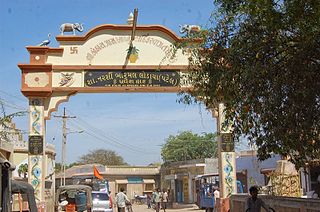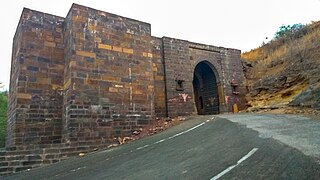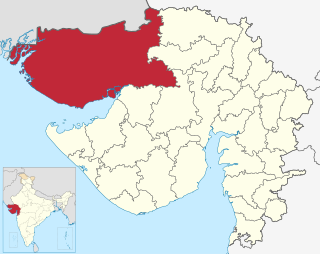
Anjar is a town, township and municipality of the Kachchh district in the state of Gujarat, India. Founded in 650 AD, Anjar is a culturally diverse town of historic importance in the region. It is home to several historic religious temples, including the Jesal-Toral Shrines built in honour of a fourteenth century couple, whose lives inspired works of art and cinema. The town was devastated by several earthquakes, including the 1819 Rann of Kutch earthquake and 2001 Gujarat earthquake. In recent years, Anjar has become a hub of manufacturing activity.

Lakhpat is a sparsely populated town and sub-district in the Kachchh district in the Indian state of Gujarat located at the mouth of the Kori Creek. The town is enclosed by 7km-long, 18th-century fort walls.
Varnu is a village in Rapar Taluka in Kutch district of Gujarat, India. The village is on the west bank of Little Rann of Kutch.

Khavda is a village in Bhuj Taluka of Kutch district of Gujarat, India. It lies on the west side of Pachham Island in Greater Rann of Kutch.

Narayan Sarovar or Narayansar is a village and place of pilgrimage for Hindus on the Kori Creek. It is located in Lakhpat taluka of Kutch district, Gujarat, India. The ancient Koteshwar temple lies only 4 km away.

Kothara is a village and a Jain pilgrimage center located in Abdasa Taluka of Kutch district of Gujarat, India.

Kanthkot fort is located near Kanthkot village, Bhachau Taluka of Kutch, Gujarat kutch kanthkot जाम श्री रायधन जी के पाटवी कुमार विक्रम संवत १२५६.मै आये है जाम श्री देदाजी के चार कुमार हुए थे जिनका आधा करछ मै भागीदार रहा है,,, देदाजी के वंशज मै पेटा साख और गाम गरास सब से बडा है,,
Amrapar is a village in Kutch district, Gujarat, India.
Fatehgadh is a town near Rapar of Kutch district of Gujarat, India.
Gedi is a village near Rapar of Kutch district of Gujarat, India.

Gundiyali is a village near Mandvi of Kutch district of Gujarat, India.

Kera is a village in Bhuj Taluka of Kutch district of Gujarat, India. This historical town has several places of interest; the ruins of an old fort and Shiva temple, and the shrine of a Muslim saint Ghulam Ali.
Pipar is a village in Lakhpat Taluka of Kutch district of Gujarat, India.
Rav is a village of three hamlets; Rav Moti, Rav Nani and Temple; in an open plain, located nineteen miles from Chobari, in Rapar Taluka of Kutch district of Gujarat, India.
Patgadh or Vagham Chavdagadh was a historical town and capital of western Kutch during rule of Chawda dynasty. The ruins of the town is located in Lakhpat Taluka in Kutch district of Gujarat, India. The village is on the west bank of Little Rann of Kutch.

The history of Kutch, a region in the extreme west of the western Indian state of Gujarat, can be traced back to prehistorical times. There are several sites related to Indus valley civilization in region and is mentioned in Hindu mythology. In historical times, Kutch is mentioned in Greek writings during Alexander. It was ruled by Menander I of Greco-Bactrian Kingdom which was overthrown by Indo-Scythians followed by Maurya Empire and Sakas. in the first century, it was under Western Satraps followed by Gupta Empire. By fifth century, Maitraka of Valabhi took over from which its close association with ruling clans of Gujarat started. Chavdas ruled the eastern and central parts by seventh century but then came under Chaulukyas by tenth century. After fall of Chaulukya, Vaghelas ruled the state. Following conquest of Sindh by Muslim rulers, Rajput Samma started moving southwards to Kutch and ruled western regions initially. By tenth century, they controlled significant area of Kutch and by thirteenth century they controlled whole of Kutch and adopted a new dynastic identity, Jadeja.

Radhanpur is a town and a municipality in Patan district in the Indian state of Gujarat. Radhanpur belonged to the Vaghelas in early years and later it was held as a fief under the Gujarat Sultanate by Fateh Khan Baloch. During Mughal period, the descendants of Babi dynasty were appointed as the governor of Radhanpur and other villages of North Gujarat. After decline of Mughal, they became free and established themselves as independent rulers. In 1743, Babi descendant Jawan Mard Khan II took over viceroyalty of Ahmedabad and controlled several villages in North Gujarat. He was defeated by Maratha Gaekwads in 1753 at Ahmedabad and Gaekwads agreed to his demand of control of villages in North Gujarat headquartered at Radhanpur State. His descendants lost some of these villages to Gaekwads subsequently. In 1813, Sher Khan made a treaty with the Gaekwar and British and became British protectorate. His descendants ruled the state until independence of India in 1947.
Prakash Gøràkhå વેડલા Suigam was a village in Vav Taluka of Banaskantha district in Gujarat, India, but it is now a Taluka of Banaskantha district in Gujarat.
Sami is a town in Sami Taluka of Patan district of Gujarat, India.

The Shiva temple, Kera, also known as Lakheshwara temple of Kerakot, is located in Kera village near Bhuj of Kutch district in Gujarat, India. The temple was built during the reign of the Chaulukya dynasty (Solankis) in the later part of the 10th Century and is dedicated to Shiva. The temple has been subjected to severe earthquake damages during the earthquake of 1819 and the Bhuj earthquake of 2001. But the temple's spire, inner sanctum and the sculptures are still in an attractive condition.










